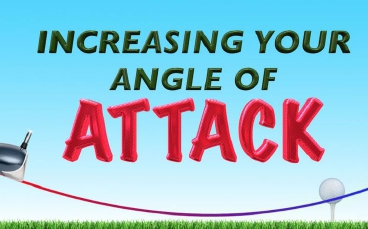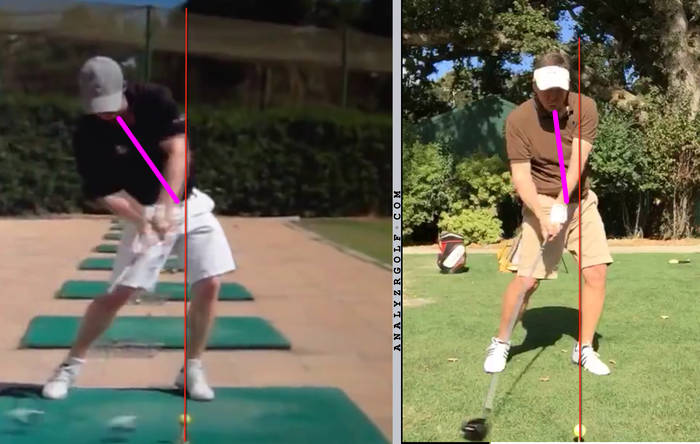Better Swing: How To Hit Farther Than Ever
Practice / Drills
Increase your angle of attack and hit the ball farther than ever. Adjusting your angle of attack you will be driving the ball more effectively. Try it!
Use angle of attack to hit your ball farther than ever!
What is Angle of Attack (AOA)?
Angle of attack, or AOA refers to whether your club is traveling more up or down when it makes contact with the ball. Changing your AOA can affect strike quality (it’s vital with shots from the ground) and distance. With shots on the ground, we generally want to be hitting slightly downwards – this is achieved by having the low point of the swing arc in front of the ball.
However, with a driver (as it is teed up), we have more options available to us. We can even hit up on the ball – a positive AOA.
The benefits of a positive AOA can be huge. In my own game, it allowed me to hit the ball much farther than before, and gave me the ability to compete with player’s much stronger than me. This is because a positive AOA allows you to launch the ball much higher, combine this with a lower spin rate (law of diminishing returns applies), and you have a recipe for some serious distance.
How do we increase AOA?
In the first picture, we have 3 possible ball positions (relative to the swing arc). The first ball (to the left on the screen) is being hit early in the swing arc – the red part, where the AOA is steeper (more downwards). Also, relatively, dynamic loft would be lower here – all resulting in a lower launch angle for the ball.
 The second ball is being hit at low point – where the AOA is neutral.
The second ball is being hit at low point – where the AOA is neutral.
The third ball, in the blue part of the swing arc, is being hit on the upswing – a positive AOA which benefits launch angle. So, in order to get the AOA more positive, we have to find a way of getting the lowest point of the swing circle further behind the golf ball.
What most amateurs do
The majority of amateurs hit their driver very much like their iron shots – on the downswing. Often it looks something like this.
Their club is traveling downwards at point of contact with the ball. Usually, they hit the ball and then their club thumps into the ground after the shot. I can usually tell if someone has a steep AOA just by looking at the underside of their driver. If the paintwork is taken off the club, or it looks overly scratched – it is a sign of a steep AOA.
Having the low point too far in front of the ball is often due to a poor set up, or certain body positions in the swing also contribute to it. Having a swing direction which is overly leftwards can be a big factor.
Before you start
Before you change the low point of your swing and start trying to hit up on the ball, we must understand that we first have to tee the ball higher than normal. This is because, as the club is hitting the ball and traveling up, it is in a part of the swing arc which is higher up than low-point. If that sounds complicated, just look at the pic below.

The ball hit at low point is teed lower than the ball teed in the blue part of the swing arc
Most amateurs who have tried to hit more up on the ball have failed because they try to maintain the same tee height as before. The club then has no chance to catch the ball on the upswing, as the ground is in the way.

With the ball teed too low, hitting on the upswing becomes an impossibility. We call this a drop-kick
Swing Tips to increase AOA
Let’s look at some of the main ways we can achieve this.
- Placing the ball more forwards in your stance – opposite left foot – places the ball in the latter part of the swing arc
- Having a wider stance exaggerates this effect
- Having more spine tilt away from the target at impact
Basically, anything that gets your head more behind behind the ball at impact will tend to help you hit more on the upswing.
Swing direction
One of the major influencers of low point position is the swing direction. Remember:
- Swinging to the right puts the low point farther back
- Swinging to the left puts the low point farther forwards
Many amateurs who struggle with a slice will start to swing left to compensate (or create a slice which at least lands on their target now). This can put the low point way ahead of the ball, dramatically steepening AOA.
Drill to increase AOA: Task led – the 3 tee drill
As a small change to the two above drills, my preferred method is to set a task for the player involving setting 3 tees up. The middle tee has the ball on it, and there are another two tees without a ball – one in front and one behind. These ‘extra tees’ are placed a little lower into the ground – as shown.

The aim of the task is to take the first two tees out of the ground, but leave the ‘target-side’ tee in the ground. Doing this will not only get the club moving upwards through impact, but it will also ensure that you hit the right height on the clubface (stopping you cheating and just thinning the ball).
A positive AOA with a well controlled swing arc height will see the first two tees stuck, but the last tee is left alone.
This is a good drill because there is no way of cheating it. Also, you can practice the drill in you back garden or garage without a ball – great practice for the winter months when you are locked inside.
Make sure to visualize the path that you want the club to take through impact – see it before you do it.

